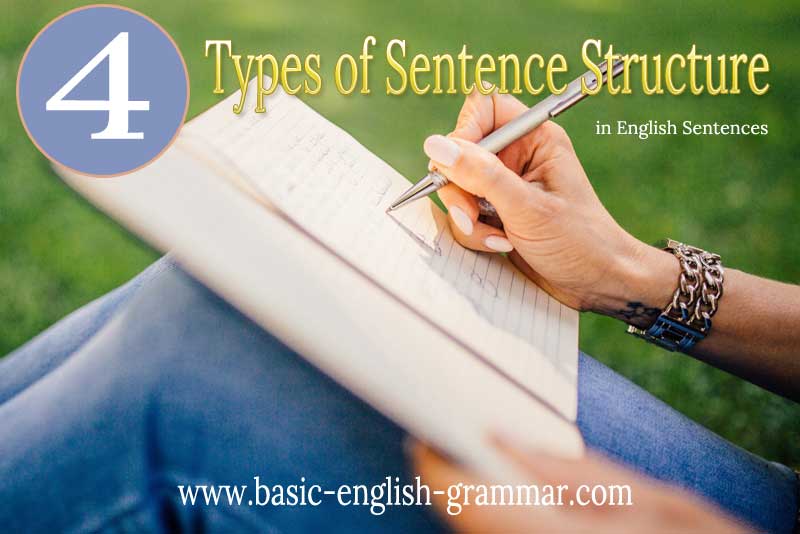There are four (4) types of English sentence structure. Once you master these four types of English sentence structures, you will find writing easier and enjoyable.
The 4 types of English sentence structure are: 1) simple sentences, 2) compound sentences, 3) complex sentences and 4) compound-complex sentences.

4 Types of English Sentence Structure
There are different ways to categorize sentences. However, for ease of learning, sentence structure is most helpful. There are four types of sentence structure. They are simple, compound, complex and compound-complex.
By the way, a sentence is a group of words that expresses one complete thought. That is, a sentence must have a subject and a verb. If a group of words does not convey one complete thought, then you have a sentence fragment. Furthermore, if a group of words is not joined together correctly, then you have a run-on sentence.
English Sentence Structures
Let’s look at the 4 types of English sentence structures with examples so that you can improve your writing and communicating skills!
1. Simple Sentences
A simple sentence has one independent clause or main clause. It has no dependent clauses or subordinate clauses.
However, a simple sentence may have a compound subject or a compound verb or it may have both a compound subject and verb.
Also it can have modifiers like an adverb or adjective or adverb phrase or adjective phrase.
In the examples below, the subject of the sentence will be underlined for easy recognition. The predicate (both simple and complete predicate) will be in red and the modifiers will be shaded yellow.
Examples of Simple Sentences
- The house caught fire. (single subject and verb)
- The old house caught fire. (old modifies house)
- The house and barn caught fire and burned down. (compound subject and verb)
- The house and barn caught fire and burned down quickly. (quickly modifies down)
I have written a more in-depth article on simple sentence structure in English sentences highlighting the subject, verb or verb phrases, predicate (both simple and complete), modifiers (both adverb and adjective) and prepositional phrases – what is a simple sentence with examples?
2. Compound Sentences
A compound sentence is made up of two or more independent clauses joined by conjunctions or punctuation (semi-colon).
A compound sentence does not have a dependent clause.
Examples of Compound Sentences
- The house caught fire, and the fire brigade extinguished the fire.
- The house caught fire; the fire brigade extinguished the fire.
The coordinating conjunctions are: for, and, nor, but, or, yet and so (see first example above).
The semi-colon joins these two independent clauses together (see second example above).
I have written a more in-depth article on sentence structures highlighting the 4 Types of Sentence Structures.
I have written a more in-depth article on coordinating conjunctions highlighting the different coordinating conjunctions with several examples – 4 Types of Conjunctions in English Grammar With Examples.
3. Complex Sentences
A complex sentence contains one independent clause and one or more dependent clauses.
An independent clause has one complete thought; whereas, a dependent clause has an incomplete thought.
For example, a dependent clause could be like this: When we returned from the football game. This group of words is an incomplete thought.
In other words, we are looking for more information to understand what it wants to say.
In the complex sentences below, I will shade the independent clauses in aqua and the dependent clauses in beige.
Example of Complex Sentences
- When we returned from the football game, the house caught fire and burned down.
- While we were at the football game, the house caught fire and burned down.
- The house, which was on the corner of the street, caught fire and burned down.
Dependent or subordinate clauses can be noun clauses, adjective clauses or adverb clauses.
4. Compound-complex Sentences
A compound-complex sentence is made up of two or more independent clauses and one or more dependent clauses.
In the compound-complex sentences below, I will only shade the dependent clauses in beige for identification.
- When we arrived home, the house caught fire, and we quickly called the fire brigade on the mobile.
- The house caught fire, and the fire brigade put the fire out before it caused any damage.
I have written another article that will help you understand sentence structures in English by highlighting the 4 Types of Sentence Structures.
A List of 4 Types of Sentence Structures
| TYPE | STRUCTURE | EXAMPLE SENTENCES |
|---|---|---|
| Simple | 1 Independent Clause | The house caught fire. |
| Compound | 2 Independent Clauses | The house caught fire; the fire brigade extinguished the fire. |
| Complex | 1 Dependant Clause and 1 Independent Clause | While we were away, the house caught fire. |
| Compound-Complex | 2 Independent clauses and 1 Dependent Clause | The house caught fire while we were away, and it quickly burned down. |
Types of English Sentence Structure Resources
4 Types of Sentence Structure With Example
English Grammar in Use by Raymond Murphy
Plain English Handbook by J. Martyn Walsh and Anna Kathleen Walsh
The Only Grammar Book by Susan Thurman
Mastering English Grammar by S.H. Burton





